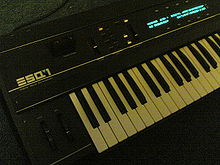Ensoniq ESQ-1
| ESQ-1 | |
|---|---|

A fully operational Ensoniq ESQ-1
|
|
| Manufacturer | Ensoniq |
| Dates | 1985 - 1989 |
| Technical specifications | |
| Polyphony | 8 voices |
| Timbrality | 9 |
| Oscillator | 3× single-cycle wavetable-lookup oscillators per voice |
| LFO | 3 (triangle, saw, square and noise) |
| Synthesis type | subtractive |
| Filter | 1 analog resonant low-pass per voice |
| Attenuator | 4 VCA (3 DCA, 1 VCA) Envelope - Four levels, four rates |
| Storage memory | 40 patches internal 80 extra with an expansion card |
| Effects | None |
| Input/output | |
| Keyboard | 61 keys |
| External control | MIDI |
Ensoniq ESQ-1 is a 61-key, velocity sensitive, eight-note polyphonic and multitimbral synthesizer released by Ensoniq in 1985. Although its voice generation is typically subtractive in much the same fashion as most analog synthesizers that preceded it, its oscillators are neither voltage nor "digitally controlled", but provided by a custom Ensoniq wavetable chip. The rest of the signal path is analog, including resonant low-pass filters.
The synth also features a fully functional, if crude by modern standards, 8-track MIDI sequencer that can run either its internal sounds, external MIDI equipment, or both, with a capacity of 2,400 notes (expandable via cartridges). It provides quantization, step-editing, primitive forms of copy/paste editing, and can be synchronized with external MIDI or tape-in clock.
ESQ-1 can store 40 presets internally, and features a cartridge slot for additional storage capability. ESQ-M, a rackmount version of the synthesizer, was released circa 1987, with the same specifications but without the sequencer.
Notably, the sound chip at the core of the synth is a brainchild of Robert Yannes, father of the popular SID chip. Other than both being based on phase accumulation, they however don't share any further similarities.
The ESQ-1 features eight voices with three oscillators per voice, and is fully multi-timbral. The wave ROM accessed by the soundchip contains 32 different waveforms, including standard synthesis waveforms such as sawtooth and square, but also less usual ones such as "piano", "voice", or "bass" (note that, although multi-sampled, these are still single-cycle waveforms, not true samples as such).
...
Wikipedia
